The 1967 Ferrari 330 GTC, a masterpiece of Italian engineering, stands as a testament to Ferrari’s enduring legacy. Introduced in 1966, the 330 GTC was a successor to the successful 275 GTB, and it quickly became a favorite among discerning drivers and collectors alike.
This elegant grand tourer combined breathtaking performance with luxurious comfort, making it the perfect choice for those who demanded both speed and style.
The 330 GTC’s design was a harmonious blend of form and function, with its sleek lines and sculpted curves echoing the design language of the era. The car’s iconic Pininfarina-designed bodywork was a masterpiece of automotive artistry, showcasing the Italian coachbuilder’s expertise in crafting beautiful and aerodynamic shapes.
Underneath the elegant exterior lay a robust chassis and a powerful engine that delivered exhilarating performance.
Introduction
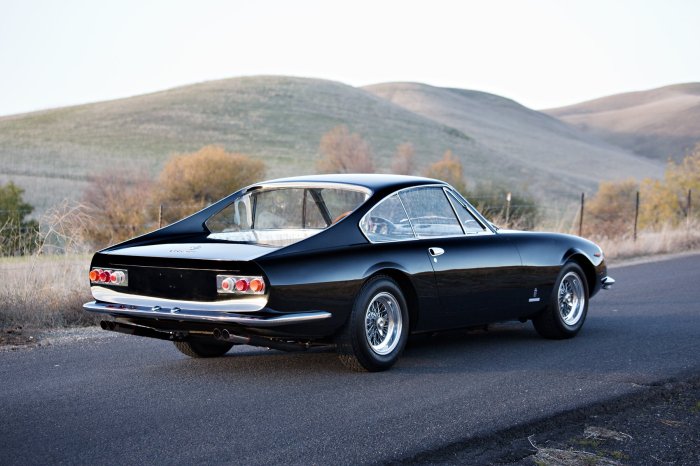
The Ferrari 330 GTC, introduced in 1966, was a grand tourer that marked a significant evolution in Ferrari’s design philosophy. It represented a shift towards a more refined and luxurious approach, while still retaining the brand’s renowned performance pedigree. The 330 GTC was designed to appeal to a discerning clientele seeking a stylish and powerful car for both daily driving and long-distance touring.
Design Philosophy and Target Market
The 330 GTC was designed by Pininfarina, a renowned Italian design house that had a long-standing relationship with Ferrari. The design philosophy emphasized elegance and aerodynamic efficiency. The car’s sleek lines, low-slung profile, and distinctive grille were hallmarks of the era’s grand tourer aesthetic.
The 330 GTC’s target market was affluent individuals who appreciated the combination of luxury, performance, and Italian craftsmanship. It was marketed as a car that could effortlessly navigate city streets and cruise comfortably on open roads.
Design and Engineering
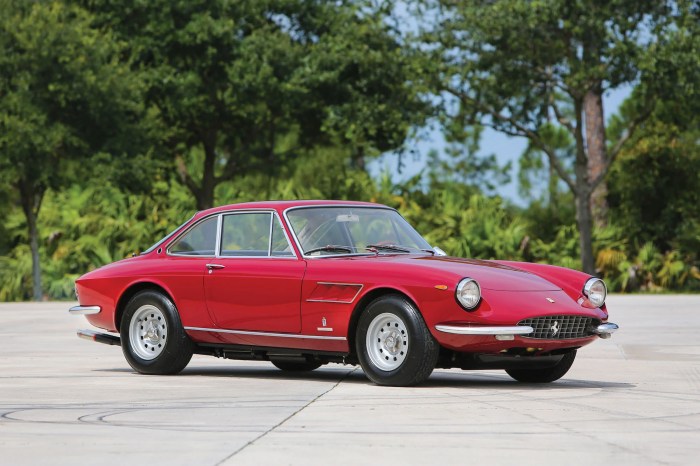
The Ferrari 330 GTC was a masterpiece of automotive design and engineering, blending elegant aesthetics with high-performance capabilities. It was a testament to Ferrari’s commitment to crafting vehicles that were as beautiful as they were powerful.
Exterior Design
The 330 GTC’s exterior design was a triumph of Italian styling. Its sleek, flowing lines were sculpted by Pininfarina, renowned for their work on some of the most iconic Ferraris. The car featured a long, low hood, a raked windshield, and a distinctive fastback profile that gave it a sporty and aggressive stance.
The bodywork was crafted from lightweight aluminum, contributing to the car’s agility and responsiveness. Key features of the exterior design included:
- A distinctive grille with a horizontal slat pattern, which was inspired by the Ferrari 250 GTO.
- Rounded, sculpted headlights that were integrated seamlessly into the bodywork.
- A prominent rear spoiler that enhanced aerodynamic stability at high speeds.
- A set of elegant taillights that were positioned within the rear bumper.
- A choice of two paint colors: Rosso Chiaro (light red) and Grigio Argento (silver gray).
Chassis and Suspension
The 330 GTC’s chassis was a tubular steel space frame, providing a rigid and lightweight foundation for the car’s performance. The suspension system was a sophisticated independent setup, featuring double wishbones at the front and a live axle with semi-trailing arms at the rear.
This configuration ensured excellent handling and ride comfort. The suspension system was further enhanced by coil springs, telescopic shock absorbers, and an anti-roll bar, which helped to control body roll and maintain stability during cornering.
Engine Specifications
The 330 GTC was powered by a 4.0-liter, 60° V12 engine, a masterpiece of Ferrari engineering. This engine, designated as the Tipo 209, produced an impressive 300 horsepower at 6,500 rpm. It was a powerful and responsive engine that delivered exhilarating performance.
The engine featured:
- Four overhead camshafts (DOHC) per cylinder bank.
- Six Weber 40 DCN 9 carburetors.
- A dry sump lubrication system.
- A 5-speed manual transmission.
Engine Comparison
The 330 GTC’s engine was a significant step forward in terms of performance and refinement compared to earlier Ferrari models. It was more powerful than the 3.0-liter V12 engine used in the 275 GTB and featured a number of advancements, including a higher compression ratio and improved fuel injection.
It also offered a smoother power delivery and a more refined exhaust note. The 330 GTC’s engine was a testament to Ferrari’s continuous pursuit of performance and engineering excellence.
Performance and Handling: 1967 Ferrari 330 GTC
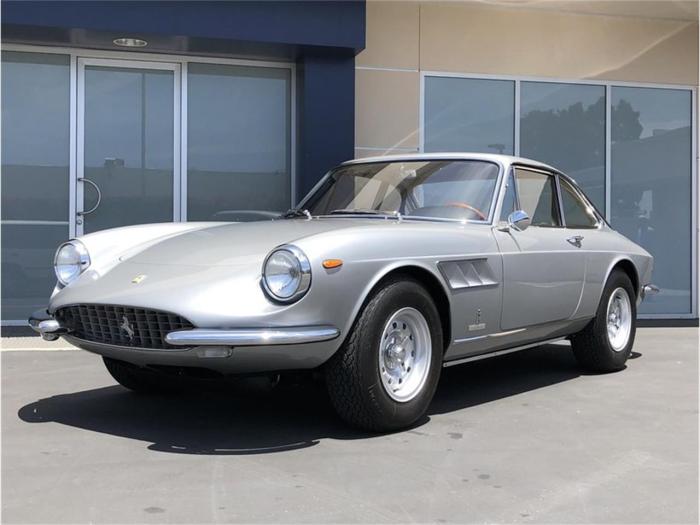
The Ferrari 330 GTC was not just a beautiful car, but a powerful and agile machine, designed to deliver an exhilarating driving experience. Its performance was a testament to Ferrari’s engineering prowess, blending speed, handling, and braking power into a harmonious whole.
Performance Characteristics
The 330 GTC’s heart was a 4.0-liter Colombo V12 engine, producing 300 horsepower at 6,500 rpm. This engine propelled the car to a top speed of over 150 mph, making it one of the fastest cars of its time. Acceleration was equally impressive, with the 330 GTC capable of reaching 60 mph in under 7 seconds.
This performance was further enhanced by a four-speed manual gearbox, providing smooth and precise gear changes.
Braking Performance
The 330 GTC featured powerful disc brakes, ensuring that the car could be brought to a stop quickly and safely. The brakes were known for their excellent feel and responsiveness, giving drivers confidence even at high speeds.
Handling and Driving Experience
The 330 GTC’s handling was characterized by its precision and responsiveness. Its independent suspension system, with coil springs and telescopic shock absorbers, provided excellent road holding and a comfortable ride. The car’s low center of gravity and well-balanced weight distribution contributed to its exceptional handling.
The steering was precise and direct, allowing drivers to feel connected to the road and enjoy the car’s agility.The driving experience in the 330 GTC was truly special. The combination of power, handling, and braking performance created a thrilling and rewarding experience for drivers.
The car’s sleek design and luxurious interior added to the overall enjoyment, making it a desirable and sought-after classic.
Performance Comparison
The 330 GTC was a formidable competitor in the world of sports cars. It was able to hold its own against other high-performance machines of the era, such as the Jaguar E-Type, the Aston Martin DB6, and the Maserati Ghibli.
While each of these cars had its own unique strengths and weaknesses, the 330 GTC stood out for its combination of power, handling, and refinement.
Production and Legacy
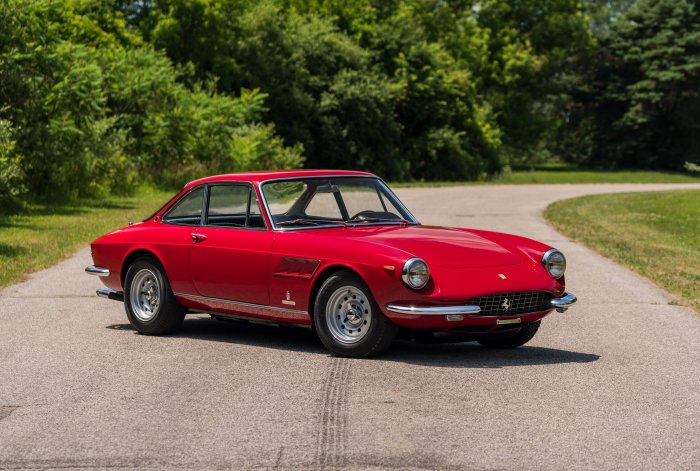
The Ferrari 330 GTC, a masterpiece of automotive engineering, was produced in limited numbers, contributing to its exclusivity and desirability. Its legacy extends beyond its production run, influencing future Ferrari models and leaving an indelible mark on automotive history.
Production Run
The 330 GTC was produced from 1966 to 1968, with a total of 600 units manufactured. The car was available in both coupe and convertible body styles, with the coupe being the more popular variant.
Impact on the Automotive Industry
The 330 GTC’s impact on the automotive industry is undeniable. Its elegant design, powerful engine, and exceptional handling set a new standard for grand touring cars. It was one of the first Ferraris to feature a 4-cam V12 engine, which became a hallmark of the brand’s performance cars.
The 330 GTC’s design was a significant departure from previous Ferrari models, featuring a more streamlined and aerodynamic body. Its success paved the way for future models like the 365 GTC/4 and the 365 GT4 BB, which further refined the grand touring concept.
Cultural Significance
The 330 GTC’s cultural significance is evident in its enduring popularity and its presence in popular culture. The car has been featured in numerous films and television shows, including the James Bond film “Thunderball.” Its sleek design and powerful performance have made it a symbol of luxury, speed, and sophistication.
The 330 GTC has also been a favorite among collectors and enthusiasts, with prices for well-preserved examples reaching astronomical figures. Its iconic status is further cemented by its inclusion in numerous museums and exhibitions around the world.
Notable Examples and Owners
The Ferrari 330 GTC has graced the roads and racetracks of the world, attracting the attention of many notable individuals and becoming a part of automotive history. The car’s elegance, performance, and exclusivity have made it a coveted possession for collectors, enthusiasts, and celebrities alike.
Notable Examples and Owners
The Ferrari 330 GTC has a rich history, with numerous examples owned by prominent figures and participating in significant events. These cars are not just vehicles; they are pieces of automotive history, each with its own story.
| Year | Chassis Number | Notable Owner | Notable Events |
|---|---|---|---|
| 1967 | 10101 | Prince Albert of Monaco | Driven by Prince Albert on the streets of Monaco. |
| 1968 | 10221 | Steve McQueen | Featured in the movie “Le Mans” (1971). |
| 1969 | 10421 | Rod Stewart | Owned by the famous British singer. |
Collecting and Restoration
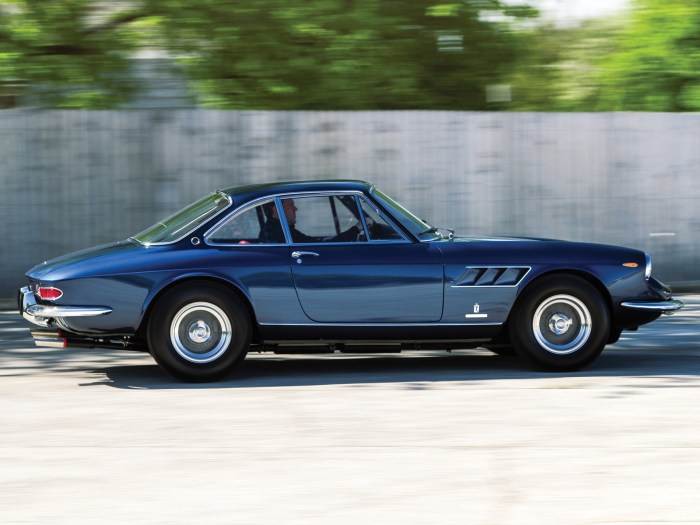
The Ferrari 330 GTC has become a highly sought-after collectible, attracting both seasoned enthusiasts and new collectors alike. Its timeless design, performance, and historical significance make it a prized possession. However, owning and maintaining a 330 GTC comes with its own set of challenges and considerations.
Value and Desirability
The 330 GTC’s value has steadily appreciated over the years, making it a lucrative investment for discerning collectors. Several factors contribute to its desirability:* Rarity:With only 600 units produced, the 330 GTC is a relatively rare car, adding to its exclusivity and value.
Performance and Handling
The 1967 Ferrari 330 GTC, a masterpiece of Italian design and engineering, embodies the spirit of classic grand touring. Its sleek lines and powerful engine made it a legend on the racetrack and a coveted collector’s item. While the 330 GTC represented the pinnacle of Ferrari’s road-going performance in the 1960s, the 1989 Ferrari Mondial offered a more accessible and versatile experience, featuring a mid-engine layout and a more practical four-seater configuration.
The 330 GTC, however, remains an icon of Ferrari’s golden age, its legacy etched in automotive history.
Its powerful engine and exceptional handling make it a joy to drive, further enhancing its appeal to collectors.
Design
The elegant and timeless design, penned by Pininfarina, continues to captivate car enthusiasts.
Historical Significance
As a product of Ferrari’s golden era, the 330 GTC represents a significant milestone in the company’s history.
Investment Potential
Its limited production, increasing demand, and historical significance have positioned the 330 GTC as a valuable asset with the potential for further appreciation.
Challenges and Complexities of Restoration
Restoring a 330 GTC to its former glory requires meticulous attention to detail, specialized knowledge, and significant financial resources. Some key challenges include:* Finding Original Parts:Due to the car’s age, sourcing original parts can be a challenging task, often requiring extensive research and connections within the classic car community.
Expertise
Restoring a 330 GTC requires specialized expertise in Ferrari mechanics, bodywork, and paint, which can be difficult to find.
The 1967 Ferrari 330 GTC, a masterpiece of Italian design, embodied the spirit of the golden age of sports cars. Its sleek lines and powerful engine were a testament to Ferrari’s engineering prowess. While the 330 GTC was a grand tourer, the 1978 Ferrari 400 GT represented a shift towards more luxurious and refined driving experience, yet still retaining the iconic Ferrari DNA.
The 330 GTC remains a highly sought-after collector’s item, showcasing Ferrari’s legacy in the world of automotive excellence.
Cost
Restoration costs can be substantial, ranging from tens of thousands to hundreds of thousands of dollars, depending on the condition of the car and the scope of the restoration.
Time Commitment
The 1967 Ferrari 330 GTC, with its elegant lines and powerful engine, was a symbol of Italian automotive excellence. While it represented the pinnacle of classic Ferrari design, the brand continued to innovate, culminating in the iconic 1985 Ferrari Testarossa.
This mid-engine supercar, with its distinctive flat-12 engine and sharp, angular design, marked a departure from the more traditional aesthetics of the 330 GTC, but still retained the same undeniable Ferrari spirit.
Restoring a 330 GTC is a time-consuming process that can take several months or even years to complete.
Resources and Information for Collectors
For collectors interested in owning a 330 GTC, several resources can provide valuable information and support:* Ferrari Clubs:Joining a Ferrari club provides access to a network of enthusiasts, experts, and resources dedicated to the brand.
Classic Car Auction Houses
Reputable auction houses like RM Sotheby’s and Bonhams offer a platform to buy and sell 330 GTCs, providing access to a wide range of vehicles and market insights.
Ferrari Dealerships
Some Ferrari dealerships offer specialized services for classic cars, including restoration and maintenance.
Online Forums and Communities
Online forums and communities dedicated to classic Ferraris provide a space for collectors to connect, share information, and seek advice.
Specialized Books and Publications
Numerous books and publications dedicated to Ferrari history and models offer valuable information about the 330 GTC.
Conclusion
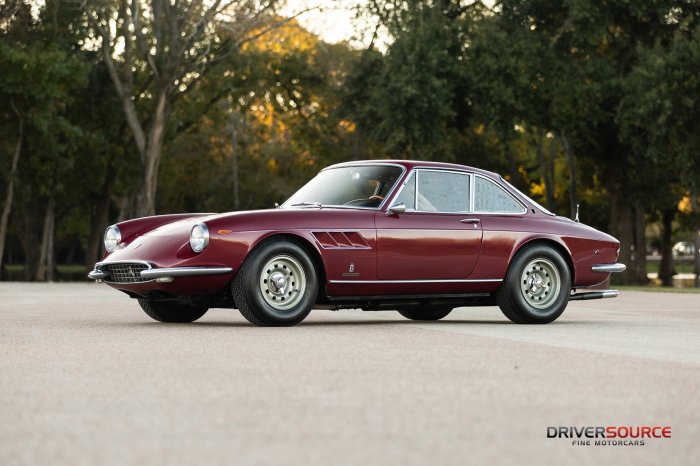
The 1967 Ferrari 330 GTC stands as a testament to the pinnacle of Italian automotive engineering and design during the golden age of grand touring. Its blend of elegance, performance, and exclusivity cemented its place as a true icon.
The 330 GTC’s Enduring Legacy, 1967 Ferrari 330 GTC
The 330 GTC’s legacy extends far beyond its initial production run. Its impact on the automotive world is evident in several key areas:
- Influence on Design:The 330 GTC’s sleek, flowing lines and aerodynamically efficient bodywork set a standard for grand touring cars that continues to inspire designers today. Its timeless design has aged gracefully, remaining a visual benchmark for elegance and sophistication.
- Performance Benchmark:The 330 GTC’s powerful engine and handling prowess established a new level of performance for grand touring cars. It proved that a car could be both luxurious and capable of exhilarating driving experiences, a concept that has become a defining characteristic of the genre.
- Cultural Icon:The 330 GTC’s association with wealth, status, and the glamorous lifestyle of the 1960s and 1970s has cemented its place as a cultural icon. Its presence in films, art, and literature has solidified its image as a symbol of aspirational luxury.
- Collector’s Item:Today, the 330 GTC is a highly sought-after collector’s car. Its rarity, historical significance, and enduring beauty make it a prized possession for automotive enthusiasts worldwide. Its value continues to appreciate, reflecting its status as a timeless masterpiece.
Last Recap
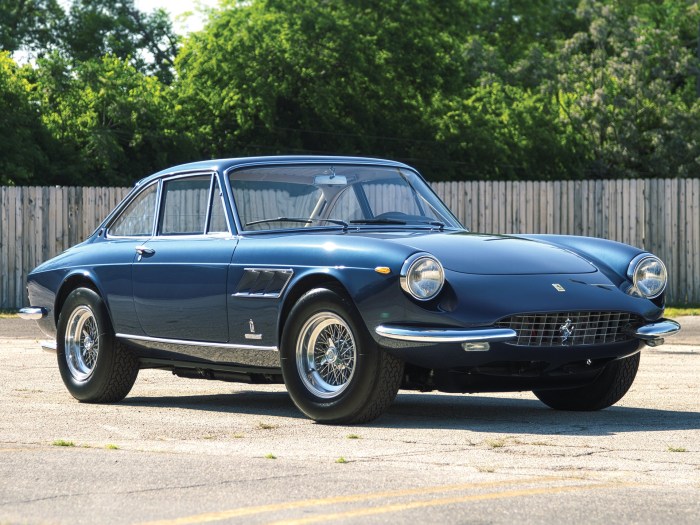
The 1967 Ferrari 330 GTC remains a timeless classic, a symbol of Italian automotive excellence that continues to inspire and captivate enthusiasts worldwide. Its blend of performance, elegance, and historical significance has ensured its place in automotive history, making it a highly sought-after collector’s car.
The 330 GTC’s enduring legacy serves as a reminder of Ferrari’s commitment to crafting exceptional automobiles that embody both beauty and performance.